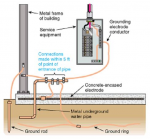Hey all. Hope all is well. Been a minute since I've been on the forum, but alas, I require the collective expertise of this community once again.
A lack of proper grounding came up as part of a customer's home inspection.
The home inspection explicitly calls for "grounding the meter," probably because the inspector is simply used to seeing ground rods at the meter, as am I.
There is also NO GEC to the water main, but that didn't come up in the inspection report.
In this case, the GEC to the water main is EXTREMELY IMPRACTICABLE. Just want clarify that my understanding is correct, that technically, less any explicit requirements from the municipality, two 5/8" ground rods at the meter is sufficient with respect to the NEC.
Standard operating procedure (SOP) in concise verbiage tells me (1) GEC to Water Main, (2) 2 Ground Rods outside at the meter.
It's been SOP for pretty much my entire career.
I understand that if you use the water main, which has a historical basis and serves as a good electrode (if not the best one), it must be supplemented (per code), which is where we arrive at driving a ground rod at the meter, which then has to be further supplemented with a second rod... but that these are not the only approved methods.

